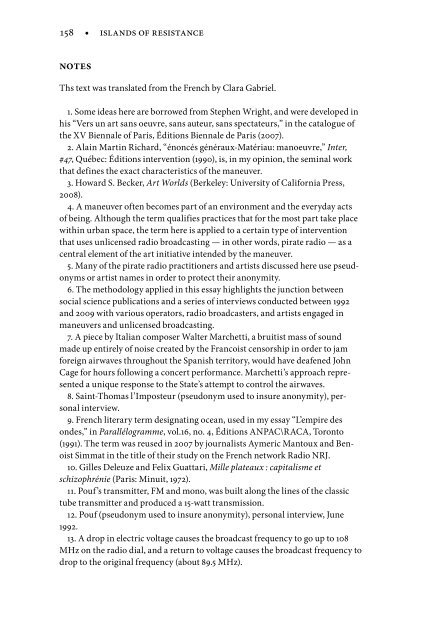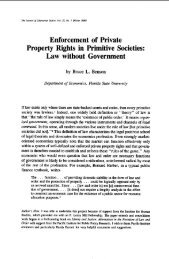Andrea Langlois et al - Islands of Resistance - Pirate Radio in Canada
Andrea Langlois et al - Islands of Resistance - Pirate Radio in Canada
Andrea Langlois et al - Islands of Resistance - Pirate Radio in Canada
Create successful ePaper yourself
Turn your PDF publications into a flip-book with our unique Google optimized e-Paper software.
158 • islands <strong>of</strong> resistance<br />
notes<br />
Ths text was translated from the French by Clara Gabriel.<br />
1. Some ideas here are borrowed from Stephen Wright, and were developed <strong>in</strong><br />
his “Vers un art sans oeuvre, sans auteur, sans spectateurs,” <strong>in</strong> the cat<strong>al</strong>ogue <strong>of</strong><br />
the XV Bienn<strong>al</strong>e <strong>of</strong> Paris, Éditions Bienn<strong>al</strong>e de Paris (2007).<br />
2. Ala<strong>in</strong> Mart<strong>in</strong> Richard, “énoncés généraux-Matériau: manoeuvre,” Inter,<br />
#47, Québec: Éditions <strong>in</strong>tervention (1990), is, <strong>in</strong> my op<strong>in</strong>ion, the sem<strong>in</strong><strong>al</strong> work<br />
that def<strong>in</strong>es the exact characteristics <strong>of</strong> the maneuver.<br />
3. Howard S. Becker, Art Worlds (Berkeley: University <strong>of</strong> C<strong>al</strong>ifornia Press,<br />
2008).<br />
4. A maneuver <strong>of</strong>ten becomes part <strong>of</strong> an environment and the everyday acts<br />
<strong>of</strong> be<strong>in</strong>g. Although the term qu<strong>al</strong>ifies practices that for the most part take place<br />
with<strong>in</strong> urban space, the term here is applied to a certa<strong>in</strong> type <strong>of</strong> <strong>in</strong>tervention<br />
that uses unlicensed radio broadcast<strong>in</strong>g — <strong>in</strong> other words, pirate radio — as a<br />
centr<strong>al</strong> element <strong>of</strong> the art <strong>in</strong>itiative <strong>in</strong>tended by the maneuver.<br />
5. Many <strong>of</strong> the pirate radio practitioners and artists discussed here use pseudonyms<br />
or artist names <strong>in</strong> order to protect their anonymity.<br />
6. The m<strong>et</strong>hodology applied <strong>in</strong> this essay highlights the junction b<strong>et</strong>ween<br />
soci<strong>al</strong> science publications and a series <strong>of</strong> <strong>in</strong>terviews conducted b<strong>et</strong>ween 1992<br />
and 2009 with various operators, radio broadcasters, and artists engaged <strong>in</strong><br />
maneuvers and unlicensed broadcast<strong>in</strong>g.<br />
7. A piece by It<strong>al</strong>ian composer W<strong>al</strong>ter March<strong>et</strong>ti, a bruitist mass <strong>of</strong> sound<br />
made up entirely <strong>of</strong> noise created by the Francoist censorship <strong>in</strong> order to jam<br />
foreign airwaves throughout the Spanish territory, would have deafened John<br />
Cage for hours follow<strong>in</strong>g a concert performance. March<strong>et</strong>ti’s approach represented<br />
a unique response to the State’s attempt to control the airwaves.<br />
8. Sa<strong>in</strong>t-Thomas l’Imposteur (pseudonym used to <strong>in</strong>sure anonymity), person<strong>al</strong><br />
<strong>in</strong>terview.<br />
9. French literary term designat<strong>in</strong>g ocean, used <strong>in</strong> my essay “L’empire des<br />
ondes,” <strong>in</strong> Par<strong>al</strong>lélogramme, vol.16, no. 4, Éditions ANPAC\RACA, Toronto<br />
(1991). The term was reused <strong>in</strong> 2007 by journ<strong>al</strong>ists Aymeric Mantoux and Benoist<br />
Simmat <strong>in</strong> the title <strong>of</strong> their study on the French n<strong>et</strong>work <strong>Radio</strong> NRJ.<br />
10. Gilles Deleuze and Felix Guattari, Mille plateaux : capit<strong>al</strong>isme <strong>et</strong><br />
schizophrénie (Paris: M<strong>in</strong>uit, 1972).<br />
11. Pouf’s transmitter, FM and mono, was built <strong>al</strong>ong the l<strong>in</strong>es <strong>of</strong> the classic<br />
tube transmitter and produced a 15-watt transmission.<br />
12. Pouf (pseudonym used to <strong>in</strong>sure anonymity), person<strong>al</strong> <strong>in</strong>terview, June<br />
1992.<br />
13. A drop <strong>in</strong> electric voltage causes the broadcast frequency to go up to 108<br />
MHz on the radio di<strong>al</strong>, and a r<strong>et</strong>urn to voltage causes the broadcast frequency to<br />
drop to the orig<strong>in</strong><strong>al</strong> frequency (about 89.5 MHz).



